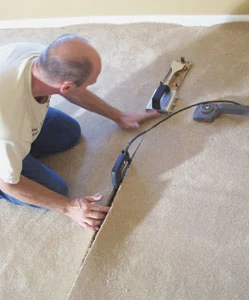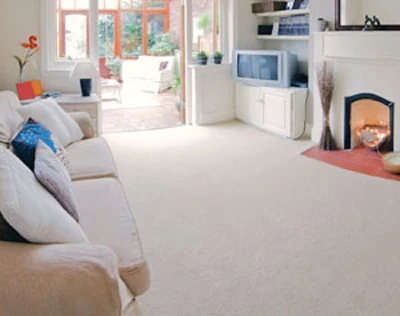By Matt Weber
Quick Tips for Wall-to-Wall Carpet
As I sat down to type this article on DIY carpet installation tips, I heard a radio advertisement for Lowe’s offering professional carpet installation of an entire house for only $97. That price covers installation of both carpet and pad (purchased from Lowe’s), but you’ll have to remove and dispose of the old carpet yourself and pay extra for any customization, including installation on steps. Still, assuming you like one of Lowe’s selections of carpets, that’s a pretty attractive offer, because installing carpet often requires specialized tools that most DIY’ers don’t have laying around the house.
Carpet tools are available for rent and purchase, but if you don’t do much carpeting, the cost of the tools probably won’t justify a purchase. And, although you’ll save money by renting, by the time you rent all the required tools you may very well have surpassed $97. Do-it-yourself carpet installation is most appropriate for small rooms that don’t require the use of a carpet stretcher, and if no seams are required—that’s good, too. The small-room scenario eliminates some of the pricier rental items, and according to some of my contractor friends, a small room can sometimes be carpeted with little more than a knee-kicker, a carpet knife and carpet tucker (broad knife).
In light of that caveat, the following are a few guidelines to consider for typical carpet installation.

Recruit Help. A roll of carpet isn’t something you’re going to be able to haul on your shoulder. Its considerable weight and bulk means you’ll need a helper (or two) just to get the carpet into the room to be installed—and to do so without scratching up the house walls or trim with the abrasive underside of the carpet as you weave the roll through the house.

Prep Steps. Rough-cut the carpet to a workable size before hauling it into the room, so you’re not lifting more than necessary and you won’t have a lot of excess material obstructing the work area.

Tack Strips. Cut the tack strips, which anchor the carpet, to fit around the perimeter of the room and hammer in place. Leave room between the tack strip and the wall equal to the thickness of the carpet. Nail the strips to the floor.
Padding. Lay the carpet padding over the entire floor, butting the seams and taping them together. Staple the pad every 12 inches, working toward the tack strips, securing the pad against the edge of the strips.
Measure and Cut. Use a carpet knife and a straight edge to cut the carpet roughly 6 inches longer and wider than the area of the room. If the room is too large for a single piece of carpet, you’ll need to join the seams with carpet seam tape, a carpet heat-bond iron and a carpet seam roller.

Place the Carpet. Center the rug in the room, with the excess lapping up the walls. Make any necessary relief cuts at wall corners so the carpet lays flat.

Knee-kicker Installation. Even for small DIY jobs, a knee-kicker is the one specialized tool necessary for carpet installation, and you can find one of these on sale for as little as $20 (at Harbor Freight Tools, www.harborfreight.com). Place the toothed end of the knee kicker on the carpet about 3 inches from the wall, starting in a corner and facing the long wall of the room. “Kick” the padded end of the tool with your knee, pushing the carpet over the tack strip to hook it in place. Use the carpet tucker to push the carpet firmly onto the tacks. Work about 3 feet down the wall, then repeat the same procedure along the adjacent short wall. Trim the carpet as you go, cutting away the excess along the wall with a carpet knife and tucking the edge into the space you left between the wall and the tack strip.


Installation Sequence. With the first corner anchored, go to the adjacent corner along the long wall and anchor both sides of that corner just like you did the first corner. For a large room, you may need a carpet stretcher to pull the carpet tightly from one end of the room to the other corner. Once the second corner is anchored, precede down the wall between the two installed corners, knee-kicking the carpet in place and trimming as you go. Follow this procedure to anchor the short wall. Next, install the second long wall and finish with the final short wall.

Carpet Stretcher. If using a carpet stretcher, start with the foot of the stretcher placed against the short wall of the starting corner. Make sure the carpet stretcher is placed against solid wall framing so you don’t inadvertently “stretch” the tool right through the wallboard of the house—a horror story relayed to me by seasoned carpet installers. Angle the stretcher about 15 degrees toward the opposite corner. A carpet stretcher is a modular device in which the installer adds lengths of tubes between the head and foot of the tool to traverse the distance across the room. Set the toothed head of the stretcher about 6 inches from the wall and push down on the handle to stretch the carpet. Once stretched, used the knee-kicker to anchor it in place.



Seaming Sections. If it’s necessary to seam the carpet, plan the layout so the seams fall in low-traffic areas of the room. Butt together two straight seams and make sure the carpet is laying flat and in line. Position a strip of hot-glue seaming tape centered beneath the edges. Slowly move the heated bonding iron under the carpet and over the tape to melt the adhesive. As you move the iron down the seam, the flaps of carpet will fall back down onto the active adhesive. Use weights or a carpet seam roller to firmly attach the carpet to the tape.


Terminating the Carpet. Where the carpet meets the perimeter walls, the edges can be concealed by base molding and/or quarter-round. Where carpet meets another flooring material, a transition molding such as a threshold, carpet bar or Z-bar binding strip may be installed for a finished look. For low-pile carpets, some installers simply fold the carpet under and staple it flatly. Other options include wooden thresholds or hot-seaming two carpet floors together if it meets another carpet of equal thickness.



